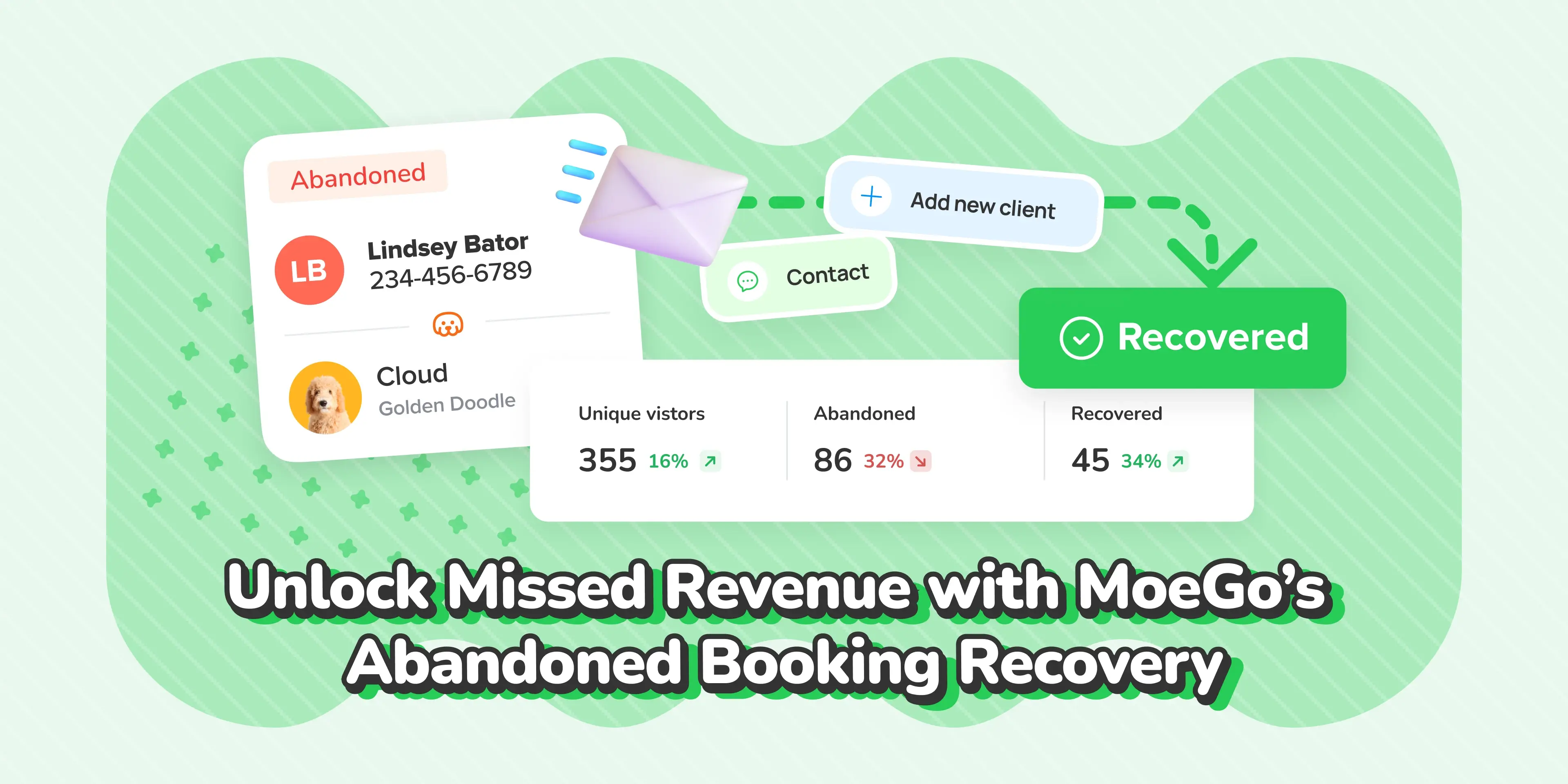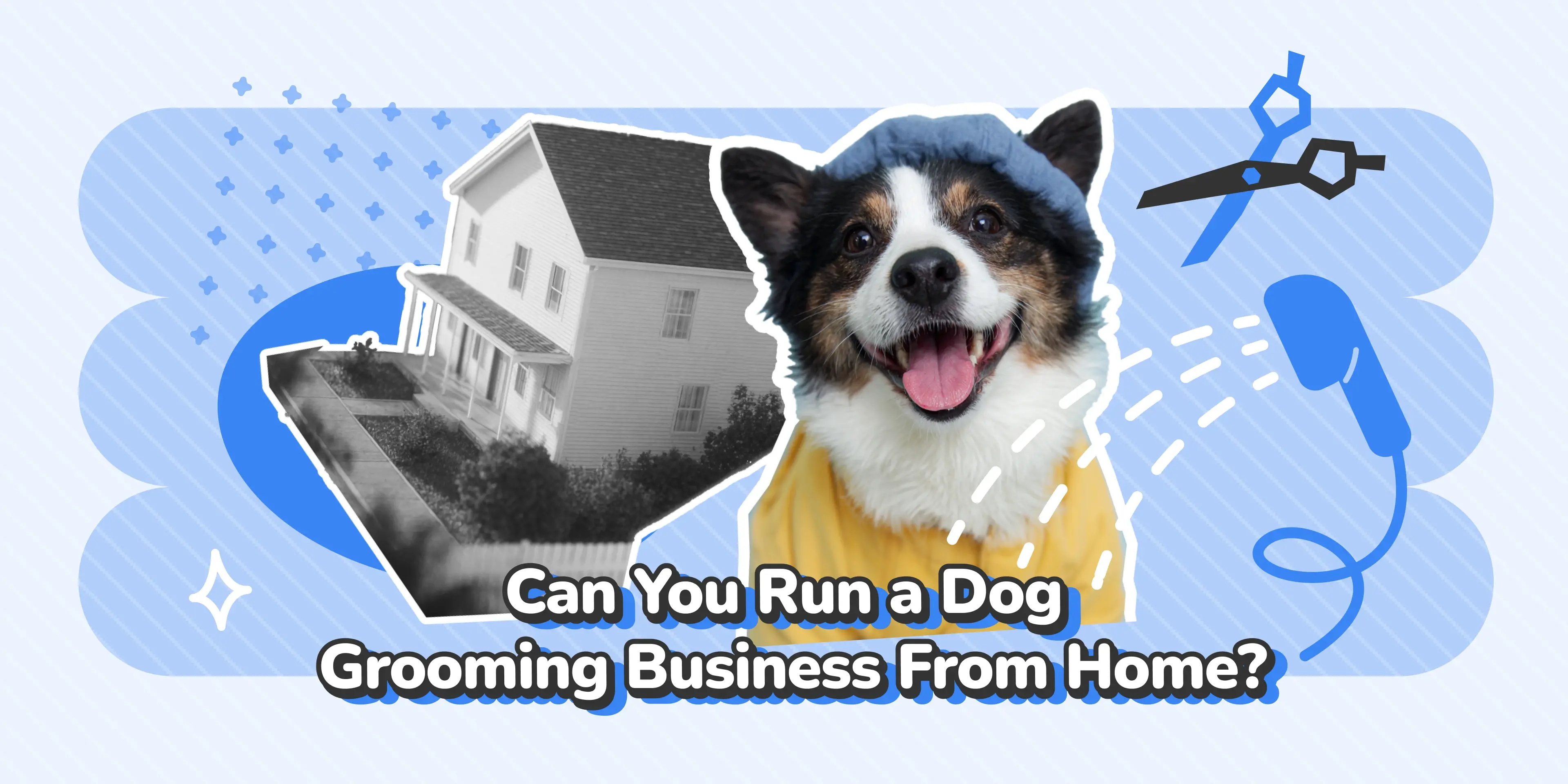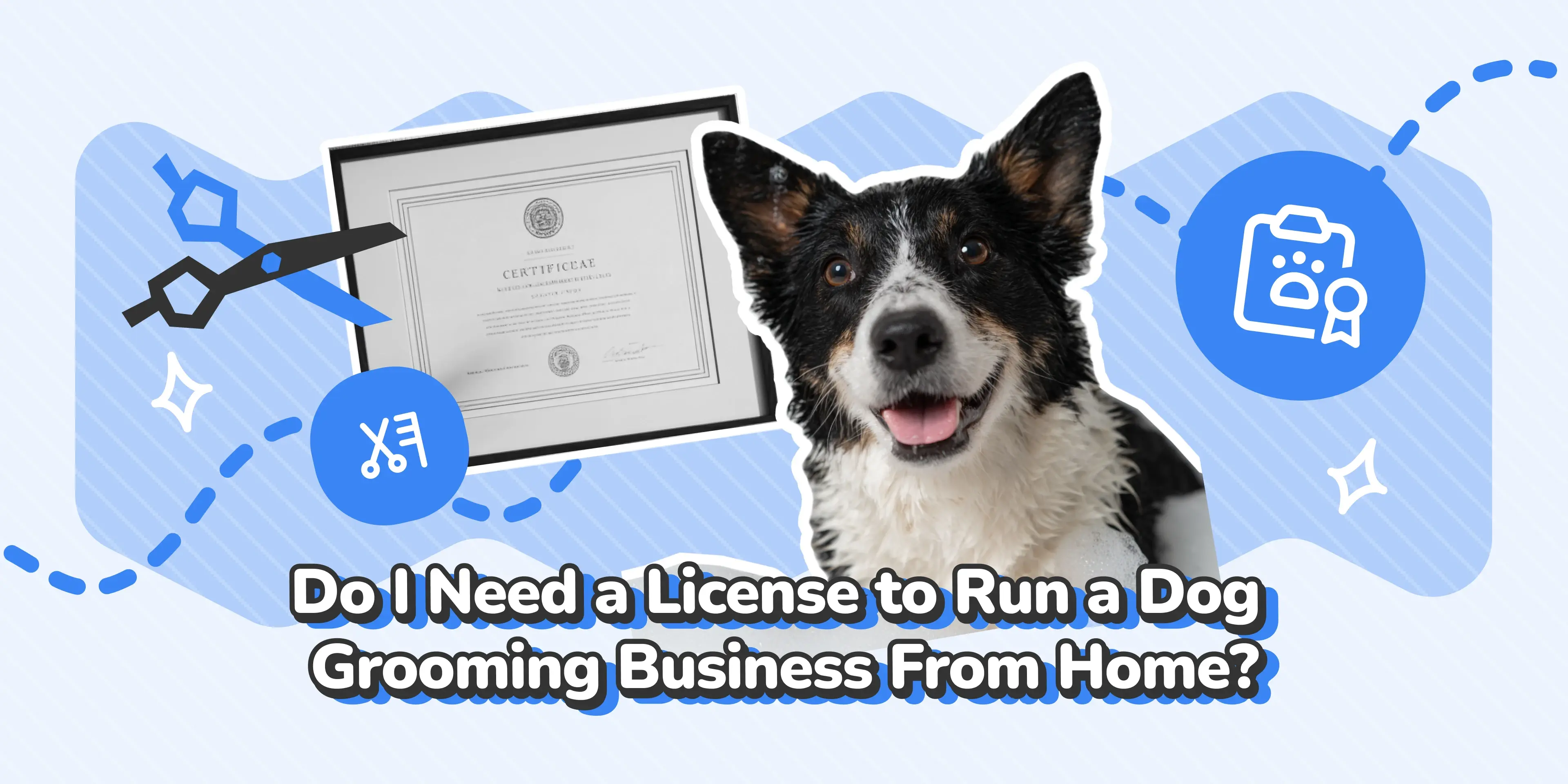Share this
Can You Run a Dog Grooming Business From Home and Actually Make It Work?
by MoeGo on Aug 19, 2025 3:28:49 PM
Can you run a dog grooming business from home?
Short answer: sometimes, but it depends on where you live, what your neighborhood rules say, and how you set up the space.
The upside is real: lower overhead, flexible hours, and a calmer environment that many clients prefer.
But the risks are real, too: zoning rules, HOA covenants, licensing and inspections, plus insurance gaps that a standard homeowners policy won’t touch.
This guide goes deep on legality, setup, common pitfalls, and the operational stack that makes a home‑based grooming studio run smoothly.
You’ll leave with a clear picture of what’s required, the trade‑offs involved, and practical steps to get started the right way.
Is It Legal to Run a Dog Grooming Business From Home?
The answer varies widely by city, county, state, and even by subdivision.
Think of legality as a three‑layer check: zoning & local ordinances → HOA/neighbor rules → licenses & insurance.
Zoning Laws and Local Ordinances
Most municipalities classify home businesses as “home occupations.”
Some allow light, low‑impact services in residential zones; others prohibit pet services at a residence outright, or allow them only with a special/use permit and strict conditions (limits on animals per appointment, parking on site, no outdoor kenneling, etc.).
For example, Sacramento’s home‑occupation document expressly prohibits pet services at the permitted residence, while still allowing a back‑office “home occupation” use.
Other jurisdictions ban pet grooming as a home occupation outright, for instance, Pima County, AZ, treating it as a use incompatible with residential zoning.
Still others allow it with conditions or permits (e.g., Phoenix requires a use permit for certain home occupations and sets limits on floor‑area use, equipment, and on‑site parking) or will issue case‑by‑case approvals with special stipulations (limits on dogs per appointment; no boarding).
Bottom line: before you buy a tub or print cards, call your planning department and ask specifically about “pet grooming as a home occupation” in your zoning district.
Expect to hear about limits on noise, traffic, signage, hours, and on‑site parking.
HOA and Neighborhood Restrictions
Even if zoning allows a home salon, your homeowners association (HOA) may still restrict home businesses and business‑related parking (e.g., no commercial vehicles in driveways) or impose pet‑related rules that affect operations.
HOAs are empowered to adopt and enforce community rules (consistent with higher laws), including pet and parking policies; violations can trigger fines or other action.
Review your CC&Rs and, if needed, request written approval for a low‑impact home occupation.
Licensing & Permits
You’ll typically need a local business license and, in some places, a specific permit or special use approval to run grooming services at home.
Some states or cities layer in animal‑facility standards (e.g., structural, sanitation, ventilation) similar to those applied to commercial grooming shops, even if your operation is modest.
Requirements vary, so confirm with your city or county clerk and animal control agency.
Insurance Requirements
Do not rely on a standard homeowners policy.
Most homeowner's policies exclude business activities and provide little to no coverage for business equipment, third‑party injury, or incidents involving animals in your care.
You’ll likely need a business policy (often a BOP), general liability, and specialty coverage like animal bailee (care, custody, control) that responds if a pet is injured, lost, or worse while in your care.
Consider endorsing or separately insuring business property/equipment, and add professional liability if you advertise specialized services.
What You Need to Set Up a Home‑Based Dog Grooming Business
A compliant, pro‑grade setup protects animals, keeps neighbors happy, and gives inspectors fewer reasons to say “no.”
Grooming Area Setup
- Ventilation and Moisture Control: Wet rooms create humidity, odors, and aerosolized fur/dander. Provide mechanical ventilation and plan for regular disinfection of vents/filters. Commercial guidance for grooming facilities stresses air quality and odor control; local animal‑facility codes often require adequate ventilation so there are no strong odors.
- Moisture‑Resistant, Non‑Slip Flooring: Choose seamless, impermeable flooring that resists claws, water, and chemicals in wet zones (tub surrounds, drying areas). Resin and other seamless systems are commonly specified in grooming/vet spaces; use slip‑resistant matting with drainage around tubs and drying stations.
- Drainage: Plan slope and drain screens to handle fur and prevent clogs. Kennel/equipment vendors recommend sloped surfaces and removable trays for hygiene.
- Adequate Lighting and GFCI Outlets: Dryers and clippers pull power; plan dedicated circuits and GFCI protection in wet areas. (Your inspector will ask.)
- Noise Management: High‑velocity dryers can exceed 100 dB, which is stressful for pets and people. Incorporate acoustic treatment, door sweeps, lined cabinets, and choose quieter equipment where possible. Professional guidelines advise minimizing excessive noise and protecting personnel.
Essential Grooming Equipment
- Core Tools: Professional table(s) with arms/harnesses, tub with sprayer, high‑velocity and stand dryers, multiple clipper sets/blades, shears, combs/brushes, shampoos, disinfectants, PPE (eye/ear protection).
- Safety Equipment: Slip‑resistant matting, tub grates, adjustable restraints used humanely, a first-aid kit, and a reliable way to secure pets away from hazards during turnover. Industry and municipal standards emphasize secure enclosures, sanitation, and ventilation to reduce injury and stress.
Client Drop‑Off and Pick‑Up Logistics
Neighbors and HOAs care about parking and traffic.
Build a routine that avoids congestion: scheduled staggered drop‑offs, a clearly signed path to the entry, and on‑site parking to keep cars off the street when possible.
Some cities explicitly require on‑site parking and cap the portion of a residence used for a home occupation; know your local limits.
Challenges of Running a Grooming Business From Home
Running a home-based dog grooming business can be rewarding, but it comes with a set of unique challenges that are easy to underestimate until you’re in the middle of them.
Being aware of these hurdles early will help you plan smarter and avoid costly setbacks.
Limited Space Compared to Commercial Shops
Even with a well-planned grooming room, you won’t have the square footage of a full salon.
At peak seasons like Christmas or summer, space becomes your biggest constraint, whether it’s drying throughput, safe pet holding areas, or storage for shampoos, towels, and clippers.
Many home groomers find themselves juggling supplies in closets or using part of the garage for overflow. The key is to think vertically with shelving and rotate stock to avoid clutter.
Noise and Hygiene Complaints From Neighbors
A high-velocity dryer can be as loud as a vacuum cleaner, times three. Add occasional barking, and sound can travel through walls or open windows.
Without proper soundproofing or dryer mufflers, noise complaints from neighbors are inevitable.
Odor is another concern. Wet dog smell and shampoos can linger unless you have strong ventilation or air purification.
Proactive measures, like sealing grooming rooms and adding exhaust fans, keep both noise and odors in check.
Regulatory Inspections and Compliance
Local health or animal control authorities may still apply commercial grooming standards to home operations.
That can mean inspections for sanitation protocols, adequate drainage, safe pet handling, and ventilation.
In some areas, you may also need to show proof of waste disposal and detailed service records.
This isn’t just red tape; non-compliance can result in fines or shutdowns, so know your local regulations inside out before your first appointment.
Balancing Work and Home Life
When your grooming table is a few steps from your living room, it’s easy to blur the line between “on” and “off” hours.
Clients may try to drop by outside of scheduled times, or you might find yourself grooming late into the evening.
The best home groomers create firm appointment windows, use online booking to control availability, and even have a separate entrance for clients to maintain boundaries.
Scaling Constraints
Success can create its own challenges.
If demand grows beyond your home’s capacity, residential zoning rules might cap the number of pets you can see in a day or limit parking and traffic. Some areas also restrict the number of animals you can have on the property at one time.
This can force you to consider moving into a commercial location sooner than expected.
Benefits of a Home-Based Grooming Business
While there are hurdles, running a dog grooming business from home also comes with perks that make it the right choice for many groomers, especially those seeking flexibility and lower costs.
Lower Overhead Costs
A home grooming setup means no retail lease, utility bills for a separate space, or additional property taxes.
Instead, your investment goes into upgrading a dedicated grooming room with professional-grade equipment.
Over time, those savings can be redirected toward marketing, better tools, or continuing education.
Flexible Working Hours
One of the biggest draws of a home-based dog grooming business is the ability to set your own schedule.
Whether you’re a morning person who prefers early starts or you want to work around school pickups, you can build a calendar that fits your lifestyle.
No commute means you can book shorter appointments and still make the day profitable.
A Calmer Environment for Many Pets
Home grooming studios often offer a quieter, more personalized experience than busy salons.
Dogs aren’t surrounded by dozens of other pets, loud dryers, and constant foot traffic.
For senior dogs, anxious pets, or those with special needs, the calmer environment can make grooming sessions faster, safer, and less stressful.
This not only improves the pet’s experience but can also lead to better reviews and repeat clients.
Stronger Local Loyalty
Serving a smaller, neighborhood-based clientele makes it easier to build genuine relationships.
You’ll often see the same dogs every few weeks, and word-of-mouth can spread quickly within local groups or online community boards.
A great client experience, paired with reliable communication, can turn your home business into the go-to grooming option in your area.
How MoeGo Helps Home Groomers Simplify Business Operations
Even a small home studio runs on process: booking, communication, records, and payments. MoeGo wraps these into a single workflow so you’re not juggling five apps.
Online Booking & Client Self‑Scheduling
Publish a simple storefront with your services, availability, add‑ons, and policies. Clients submit requests anytime; you approve, decline, or waitlist in one queue.
For boarding/daycare add‑ons or evaluation notes, the booking flow supports multi‑step details.
Mobile groomers can set service areas and day‑by‑area rules to avoid out‑of‑zone requests.
Automated Reminders & Confirmations
Cut no‑shows with first, second, and general reminders, set to your timing and channel (SMS/email). Templates can differ by service type (grooming, boarding, daycare) and support variables for fast personalization.
Digital Client Profiles & Pet History
Keep everything in one place: notes, photos, incident history, card‑on‑file status, and payment history, so repeat grooms are consistent even if a different stylist steps in.
Route Planning & Service Zones for Mobile Add‑Ons
If you add mobile days, Map View optimizes routing, shows drive time/distance on a timeline, and helps you assign the right staff to the right area. That reduces backtracking and fuel costs.
In‑App Payments and Business Management
Take payment in the app or on desktop, charge cards on file, send online invoices, and protect revenue with deposits or pre‑auths via MoeGo Pay.
Close out quickly and keep your books clean.
Conclusion: Is Running a Home‑Based Grooming Business Right for You?
A home studio can be a smart path if your location allows it and you set it up like a professional space.
Do the hard checks first: zoning and permits, HOA sign‑off, and the right insurance (general liability + animal bailee at a minimum). Design the room for ventilation, drainage, and noise control; plan parking and drop‑offs; and set boundaries so work doesn’t overrun your home.
On the operations side, an integrated stack, online booking, reminders, client records, routing, and payments keep things smooth without hiring a front desk.
If your local rules allow running a dog grooming business from home, and you’re willing to invest in a compliant, well‑designed space, it can deliver low overhead, flexible hours, and a steady, loyal client base.
If they don’t, consider a small commercial suite or a mobile add‑on—your systems, policies, and workflow will carry over either way.
Ready to make the leap? Start your home grooming business on the right foot. Try MoeGo today and see how easy running a professional operation from home can be.
FAQs
Is it legal to run a dog grooming business from home in my city?
It depends on your home‑occupation rules. Some cities prohibit pet services in residential zones (e.g., Sacramento’s home‑occupation document), while others require a use/special permit or impose conditions like on‑site parking and limits on animals per appointment. Always confirm with your planning department before you set up.
Do I need special insurance for a home‑based grooming business?
Yes. Standard homeowners' policies usually exclude business activities and won’t protect you for incidents involving pets in your care. Look at a BOP/general liability and add animal bailee coverage (care, custody, control). Consider equipment coverage and professional liability as your services expand.
What permits or licenses are typically required?
A local business license is common; some jurisdictions require a specific permit or special use approval for grooming at a residence. Animal‑facility standards (sanitation, ventilation, secure housing) may apply even at home. Check with your city/county clerk and animal services for exact requirements.
How should I design the room to avoid complaints?
Plan for ventilation/odor control, waterproof seamless flooring with good drainage, and noise reduction (dryers can exceed 100 dB). Stagger drop‑offs and provide on‑site parking to reduce traffic. These details matter for neighbor goodwill and inspections.
Can an HOA stop me if the city allows it?
Possibly. HOAs can enforce private covenants on pets, parking, and home businesses (subject to higher law). Review your CC&Rs, ask for written approval if needed, and make sure business vehicles and client traffic comply with rules.
How can software help a one‑person home studio?
Use online booking to cut phone tag, reminders to reduce no‑shows, client profiles to keep history consistent, Map View/service zones if you add mobile days, and in‑app payments to get paid fast. Systems keep a small studio professional and scalable.

Unlock Missed Revenue with MoeGo’s Abandoned Booking Recovery for Pet Care Providers

Can You Run a Dog Grooming Business From Home and Actually Make It Work?

Do I Need a License to Run a Dog Grooming Business From Home?
Share this
- August 2025 (4)
- July 2025 (11)
- June 2025 (1)
- May 2025 (7)
- April 2025 (13)
- March 2025 (6)
- February 2025 (4)
- January 2025 (8)
- December 2024 (7)
- November 2024 (6)
- October 2024 (3)
- September 2024 (1)
- August 2024 (2)
- July 2024 (1)
- May 2024 (2)
- April 2024 (1)
- March 2024 (3)
- February 2024 (3)
- January 2024 (2)
- December 2023 (6)
- November 2023 (7)
- October 2023 (7)
- September 2023 (8)
- August 2023 (7)
- July 2023 (3)
- June 2023 (2)
- May 2023 (4)
- April 2023 (2)
- March 2023 (9)
- February 2023 (1)
- January 2023 (1)
- December 2022 (1)
- November 2022 (5)
- October 2022 (1)



